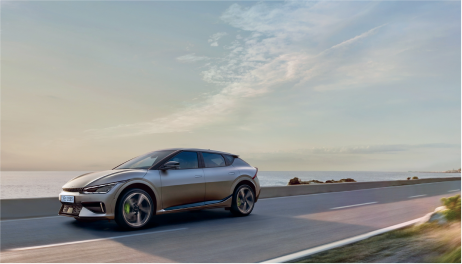Reduce your environmental impact

The shift toward vehicle electrification and the expansion of electric vehicle charging infrastructure are critical responses to environmental concerns and evolving emissions regulations. Various stakeholders, including fleets and fleet operators, multifamily unit owners, workplace charging stakeholders and public charging stakeholders, recognize the importance of reducing environmental impact.
Fleets/ Fleet operators
Fleet operations are major contributors to transportation emissions given that they frequently consist of medium and heavy duty vehicles which produce far greater emissions than an average passenger vehicle. Electrifying fleets significantly reduces greenhouse gas (GHG) emissions, nitrogen oxides (NOx) and particulate matter (PM). Stringent emissions standards from bodies like the EPA drive fleet operators toward cleaner technologies. EVs emit zero tailpipe emissions, aiding compliance with regulations and improving urban air quality. Cost savings from reduced fuel and maintenance expenses further incentivize fleet electrification, promoting sustainability and efficiency.
Multifamily unit owners
Installing EV charging stations meets growing demand and supports environmental sustainability. Providing residents access to charging facilities reduces carbon emissions and fosters cleaner living environments. Charging infrastructure can attract eco-conscious tenants, enhance property value and align with local incentives promoting sustainable practices.
Workplace charging stakeholders
Workplace charging stakeholders, including building owners and employers, play key roles in EV adoption. Offering charging stations encourages employees to switch to EVs, reducing their carbon footprints and commuter emissions. Workplace charging aligns with corporate sustainability goals, boosting reputations and demonstrating environmental responsibility. Compliance with regulations such as California's ZEV program is facilitated through workplace charging.
Public charging stakeholders
Public charging stakeholders are crucial in developing robust EV infrastructure. Expanded public charging networks support EV adoption, reducing overall transportation emissions and addressing range anxiety for consumers. Regulatory frameworks like the EU's Green Deal emphasize the importance of comprehensive charging networks in achieving significant emissions reductions by 2050.
Reducing environmental impact is a driving force behind fleet electrification and EV charging infrastructure expansion. Stakeholders across fleets, multifamily units, workplaces and public spaces contribute to cleaner environments and regulatory compliance. Understanding these imperatives enables stakeholders to promote sustainable transportation solutions and advance the global transition to electric mobility.
Try using our Business EV Tool to learn more
The environmental impact of EVs: a holistic perspective
As the global shift towards sustainable transportation gains momentum, understanding the nuanced environmental benefits of adopting electric vehicles (EVs) becomes crucial for diverse stakeholders – fleet operators, multifamily unit property owners, workplace charging stakeholders and public charging operators. The positive impact of EVs extends beyond tailpipe emissions, encompassing manufacturing considerations, labor dynamics, geopolitical shifts and the evolving energy landscape.
Emissions: unpacking the layers
When evaluating the environmental impact of electric vehicles, it's essential to delve into different types of emissions categorized as Scope 1, 2 and 3. Scope 1 emissions involve direct emissions from owned or controlled sources, like vehicle tailpipe emissions. Scope 2 includes indirect emissions from purchased electricity, while Scope 3 accounts for indirect emissions throughout the entire value chain, including manufacturing, supply chain and end-of-life considerations.
Electric vehicles significantly reduce Scope 1 emissions, offering a cleaner alternative to traditional internal combustion engines. However, to grasp the full environmental picture, stakeholders must consider the entire life cycle, from raw material extraction to vehicle production and disposal.
Manufacturing impact and geopolitical considerations
The production of EVs involves mining and processing raw materials like lithium, cobalt and nickel, leading to environmental impacts such as habitat disruption and resource depletion. Additionally, labor and geopolitical considerations come into play as demand for these materials fuels global trade and potential migration patterns.
Navigating this complex landscape requires acknowledging upfront tradeoffs. While manufacturing an EV may have a higher initial environmental impact compared to traditional vehicles, the long-term benefits emerge when the vehicle is in use, emitting significantly lower or zero emissions over its lifespan.
Grid energy makeup: a dynamic factor
Another crucial aspect is the role of the electricity grid in determining overall emissions reductions. As grid operators and energy producers shift towards renewable sources, the carbon footprint of EVs decreases. Therefore, stakeholders should recognize that the environmental impact of EVs is intertwined with the broader transformation of the energy sector.
Takeaways for stakeholders
1. Evaluate the entire life cycle
Consider the holistic life cycle of EVs, from manufacturing to end-of-life, to understand the true environmental impact.
2. Be mindful of emission scopes
Assess Scope 1, 2 and 3 emissions to comprehensively gauge the environmental footprint, keeping in mind the broader impact beyond vehicle operation.
3. Consider upfront tradeoffs
Acknowledge the initial manufacturing tradeoffs, understanding that the environmental benefits accrue over the vehicle's operational life.
4. Promote renewable grid energy
Advocate for and support initiatives that accelerate the transition to renewable energy sources, contributing to a cleaner grid.
While adopting electric vehicles is a significant step, stakeholders can enhance their environmental impact reduction efforts by optimizing existing vehicle operations. This includes efficient vehicle use, reducing commuting patterns through remote work options and proper vehicle maintenance. By adopting a comprehensive and mindful approach, each stakeholder contributes to the larger goal of sustainable and eco-friendly transportation.









